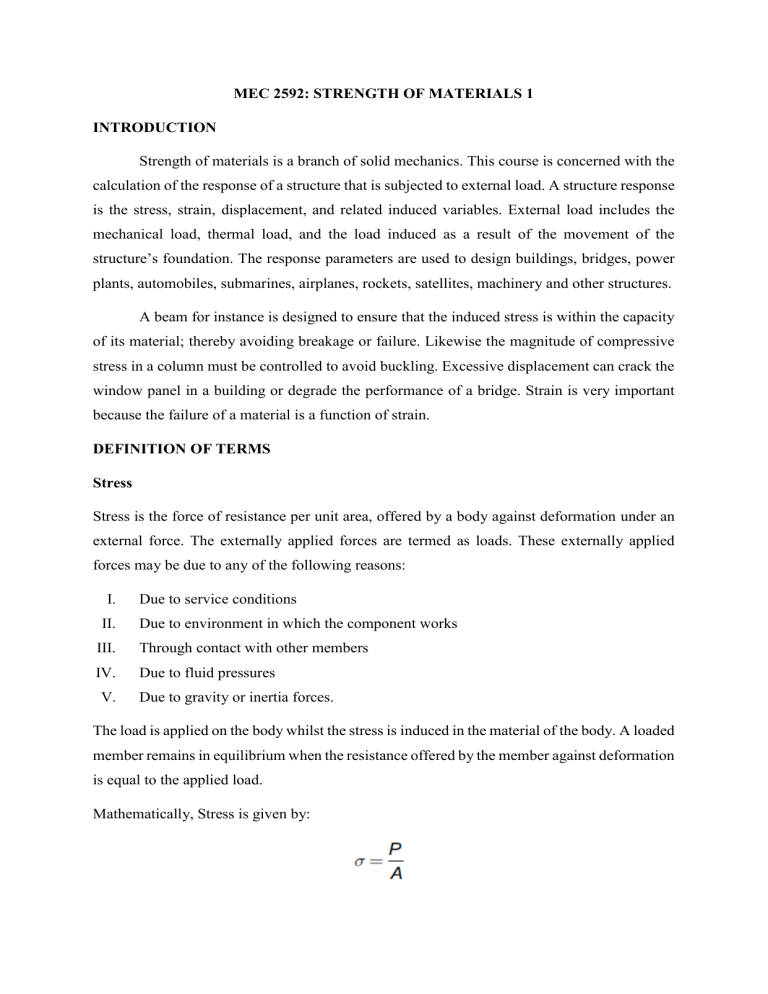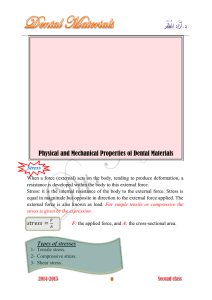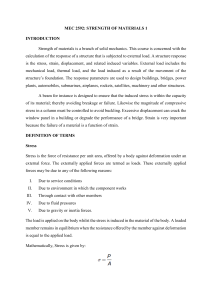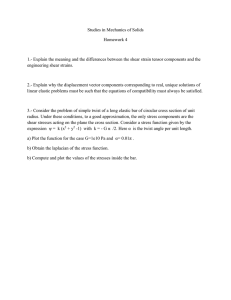Strength of Materials Course Material: Stress, Strain, Mechanics
advertisement

MEC 2592: STRENGTH OF MATERIALS 1 INTRODUCTION Strength of materials is a branch of solid mechanics. This course is concerned with the calculation of the response of a structure that is subjected to external load. A structure response is the stress, strain, displacement, and related induced variables. External load includes the mechanical load, thermal load, and the load induced as a result of the movement of the structure’s foundation. The response parameters are used to design buildings, bridges, power plants, automobiles, submarines, airplanes, rockets, satellites, machinery and other structures. A beam for instance is designed to ensure that the induced stress is within the capacity of its material; thereby avoiding breakage or failure. Likewise the magnitude of compressive stress in a column must be controlled to avoid buckling. Excessive displacement can crack the window panel in a building or degrade the performance of a bridge. Strain is very important because the failure of a material is a function of strain. DEFINITION OF TERMS Stress Stress is the force of resistance per unit area, offered by a body against deformation under an external force. The externally applied forces are termed as loads. These externally applied forces may be due to any of the following reasons: I. II. Due to service conditions Due to environment in which the component works III. Through contact with other members IV. Due to fluid pressures V. Due to gravity or inertia forces. The load is applied on the body whilst the stress is induced in the material of the body. A loaded member remains in equilibrium when the resistance offered by the member against deformation is equal to the applied load. Mathematically, Stress is given by: Where; σ = stress/intensity of stress (N/𝑚2 or Pa) P = External force or load (N) A = Original cross-sectional area (𝑚2 ) Figure 1: External loading force P and associated Resisting Force Types of stress There exist only two basic types of stresses: normal stress and shear stress. Other stresses either are similar to these basic stresses or are a combination of these e.g. bending stress is a combination of tensile, compressive and shear stresses. Torsional stress, as encountered in twisting of a shaft is a shearing stress. 1. Normal stresses: If the stresses are normal to the areas concerned, then these are termed as normal stresses. The normal stresses are generally denoted by a Greek letter (s). Figure 2: Uniaxial state of stress Normal stresses are also known as axial state of stress. If the stress acts in only one direction (axis) as in the figure above, then it is known as uniaxial state of stress. However, such a state rarely exists, therefore we have biaxial and triaxial state of stresses where either the two mutually perpendicular normal stresses acts or three mutually perpendicular normal stresses acts as shown in the figures below: Figure 3: Biaxial and Triaxial states of stress Types of normal stresses I. Tensile stress (𝝈𝒕 ) If a component/member is subjected to a tensile force which tends to cause the elongation of the component, the associated stress is known as tensile stress. Tensile stress is always positive (i.e. σt > 0). A member subjected to an external tensile force, P, and tensile stress distribution due to the force is shown in the below figure. Figure 4: Tensile axial loading and associated tensile stress II. Compressive stress (𝝈𝒄 ) If a component/member is subjected to a compressive force which tends to cause the shortening of the component, the associated stress is known as compressive stress. Compressive stress is always negative (i.e. σc < 0). A member subjected to an external compressive force, P, and compressive stress distribution due to the force is shown in the below figure. Figure 5: Compressive axial loading and associated compressive stress A special type of compressive stress is the bearing stress. Bearing Stress: When one object presses against another, a bearing stress is induced. Figure 6: Bearing stress 2. Shear stress (Ʈ): When a component/member is subjected to an external load which is parallel to the surface of the component, the said load is called shear force and the associated stress is known as shear stress. Now Let us consider the situation, where the cross – sectional area of a block of material is subjected to a distribution of forces which are parallel, rather than normal, to the area concerned. Such forces are associated with a shearing of the material, and are referred to as shear forces. The resulting stress induced by such forces are known as shear stresses. A shear stress is therefore induced when two component in contact with each other slide against each other. Figure 7: Transverse/Shear force inducing shear stress Figure 8: Two components sliding against each other Mathematically, the mean shear stress is given by: 𝑃 Ʈ=𝐴 Where; P is the total shear force and A the area over which it acts. Strain (ɛ) When a body is subjected to an external force known as load, there is some change in dimension of the body. The ratio of the change in dimension of the body to the original dimension is known as strain. Strain is dimensionless. The types of strain include: Tensile strain, compressive strain, volumetric strain, and shear strain. Tensile strain (𝜺𝒕 ) If there is an increase in length of a body due to an external load, the ratio of the increase in length to the original length of the body is known as tensile strain. 𝜺𝒕 = 𝚫𝐋/𝑳𝒐



